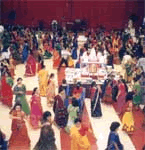Home :: Festival tour :: Navratri
NAVRATRI
FACTS & FIGURES
Time of the year - October/November every year
Places to Visit - All over India, especially North-west India
Duration - Nine nights

THE FESTIVAL
Come October, and it is time to put all routine and mundane chores aside and prepare for the gay abandon that marks the nine days of festivity, popularly known as Navratri. Though the ways of celebrating differ, these nine days are considered auspicious and pious all over the country and are celebrated with enthusiasm
CELEBRATIONS
The nine-day celebration is compartmentalized in certain parts of the country, dedicating three days each to a trinity of goddesses: to Durga the goddess of valor, to Lakshmi the goddess of wealth and to Saraswati the goddess of knowledge.
The one thing that remains constant in most parts of the country is that daytime is exclusively for prayers, fasting, and solemnity while the nights are spent in joy and revelry. Men, women, and children, who have fasted during the day, have a light repast of fruit or other non-cereals at night before going out to enjoy the festive season.
The nightly festivities too, vary from region to region. The most famous and colorful are the Dandiya and Garba dances of the western states of Gujarat, Rajasthan and Maharashtra. The dancers move around in a circle, sometimes with different steps, in pairs or in groups around a lamp lighted to represent the Eternal Light of the Mother Goddess. In public squares, a garbi or mandvi (an ornate wooden, brass, silver of stainless steel frame), further decorated with shining tinsel and illuminated with dozens of twinkling oil lamps is placed in the center.
In the eastern states too, this is a time for music and dance. Groups and residents' associations in towns and cities erect beautiful marquees, where they install the idol of the Mother Goddess. In Calcutta, as also other places, there are competitions held and the most beautiful and creatively done marquee gets a prize. For all the nine days, the marquee becomes the center of all activity where cultural events and competitions are organized every day.
In Punjab, people organize Jagrans to sing devotional songs all night in praise of the Mother Goddess. Solemnity and piety mark these nine days as even those Punjabis who do not keep a fast, stop eating non-vegetarian and impure food items like onion and garlic.
Another part of the Navratri celebrations is the Ramlila. In places like Delhi and Uttar Pradesh, almost every locality has its own group of actors re-enacting episodes from the life of Lord Rama. This is probably because, the day after Navratri, i.e. on the tenth day of Ashvin called the Vijaya Dashami, it is said that Lord Rama killed Ravana and other demons to rid the earth of evil.
LEGENDS
This festival commemorates the victory of Goddess Durga over a demon, Mahishasur. Endowed with power by the blessing of Lord Shiva, the demon started destroying innocent people. The gods then invoked Goddess Durga and asked for her help. The goddess, astride a lion, fought with the demon and cut off his head.
A Mesopotamian inscription that dates to the period before Christ, describes the Mother Goddess as "the remover of the calamities of the people". The Egyptian Goddess Isis, Ishtar of Babylon and Ijani of Sumer bear a close resemblance to Amba, Kali and other goddesses of India.
PLACES TO VISIT
Though the festival Navratri is celebrated all over India, the celebrations that are really worth experiencing happen in the northern and western region of the country. One can witness the elaborate, ritualistic worship, while indulging in traditional delicacies too.



